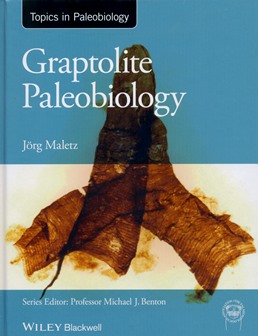
Graptolites might have lost some of their utilitarian appeal even to Palaeozoic biostratigraphers but they have gained in palaeobiological interest over the last few decades.
Graptolite Paleobiology marks a useful point in graptolite studies when it is appropriate to take stock of what has been achieved.
Arguably the last time this happened was in 1955 when Bulman wrote the first edition of the graptolite volume of the
Treatise on Invertebrate Palaeontology. Jörg Maletz and his contributors are to be congratulated on pulling together such a considerable body of research, which stretches back nearly 300 years, and producing such a beautifully illustrated and informative book, which deserves a place in every geological library.
It was in 1735 when Linnaeus first noticed this somewhat enigmatic group of fossils. He coined the name
Graptolithus, derived from the Greek via modern Latin and meaning 'written rock', although he thought that they were the fossil remains of plants.
Maletz reviews the progress that has been made especially since the early decades of the 19th Century. At that time graptolite studies were broadly divided between a European academic tradition with a biological approach to the fossils, especially in Sweden and subsequently in Poland, whereas in Britain the approach was a more utilitarian one of biostratigraphical studies. Although there was of course a more general international interest in the taxonomy and evolution of the graptolites, this progressed quite independently of any need to understand their biological affinities. Conodont research had a similar history of development.
Only in the mid-20th Century did palaeobiological and biostratigraphical approaches begin to merge. As with that other group of enigmatic marine Palaeozoic fossils (the conodonts), the underlying biological problem with graptolites was the zoological identity of the graptolite organism. Although microscope studies by Swedish palaeontologists of chemically isolated specimens had already presented clues as to the real affinities of graptolites with pterobranchs, it took another 70 years before the new technologies of scanning and transmission electron microscopy revealed the true connection.
Despite the diminishing number of graptolite researchers, great progress has been made across the whole range of graptolite studies in recent decades. Palaeobiology cannot stand alone without support from taxonomic and evolutionary research. As Maletz shows so clearly, all have benefited from the ability to examine chemically isolated specimens by electron microscopy both SEM and TEM. It was Crowther’s ‘breakthrough’ recognition in the late 1970s of the nature and origin of cortical ‘bandages’ in the structure of the graptolite stipe that led the way.
Much of the graptolite research literature is notoriously scattered and often hard to access but Graptolite Paleobiology provides an excellent digest of information and ought to be available to all students of palaeontology and essential reading for all advanced students.
Reviewed by Douglas Palmer
GRAPTOLITE PALEOBIOLOGY by JÖRG MALETZ. Wiley Blackwell. 2017. ISBN 978-1-118-51561-7. Hbk 323pp.